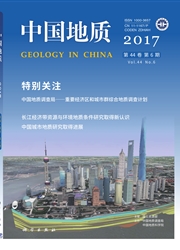

 中文摘要:
中文摘要:
华南地区早中生代经历了强烈的构造变形和岩浆活动,构造动力体制发生了重大的转换。这个时期大地构造过程及其发生的构造动力学背景一直是地学界争议的焦点问题之一。本文在系统总结前人工作成果的基础上,论述了华南早中生代构造变形样式和岩浆活动序列,区分了印支构造事件和早燕山构造事件及其产生的地质效应。研究结果表明,印支构造事件发生于中、晚三叠世(245~225Ma),构造运动产生的变形形迹主要表现为近东西向褶皱和冲断-推覆构造以及NE-NNE向左旋走滑韧性剪切,其动力与华南-华北板块沿秦岭—大别造山带的陆-陆碰撞和华南地块南缘古特提斯洋的俯冲增生作用有关。这次挤压构造事件导致华南东部加里东褶皱基底强烈复活,地壳重熔型花岗岩沿十万大山—云开大山—武夷山构造带和雪峰山地区分布。早侏罗世早期(205~190Ma)在华南存在一个岩浆活动沉寂期,早侏罗世晚期(190~180Ma)沿南岭构造带发育具有伸展特征的A型花岗岩和双峰式火山岩。起始于中侏罗世晚期(~170Ma)的早燕山构造事件,在华南形成了宽1300km、NE-NNE向褶皱逆冲构造系统,地壳增厚作用和壳幔相互作用导致了软弱的华夏加里东褶皱基底的再次强烈复活,诱发了强烈的岩浆活动,东南沿海地区火山弧相继出现。这期构造事件记录了东部大洋板块向华南大陆之下低角度俯冲作用过程,并主导了华南晚中生代一系列陆内构造和岩浆活动。
 英文摘要:
英文摘要:
South China experienced intense tectonic deformation and magmatism in Early Mesozoic, which resulted in profound change of the geodynamic regime. The processes and settings of the early Mesozoic geotectonic processes have long been a subject of controversy. Based on a summarization of previous research achievements, this paper deals with tectono-sedimentary layers, Early Mesozoic t-ectonic deformation styles and magmatic sequence, with the purpose of distinguishing between Indosinian and early Yanshanian tectonic events as well as their geological effects. It is shown that the Indosinian tectonic event occurred in Middle-Late Triassic (245-225Ma) and was featured by nearly EW-trending fold-and-thrust belts and NE-NNE striking ductile shear zones, which were dynamically related to the Triassic collision between theSouth China Block and the North China Block along the Qingling-Dabie orogenic belt and also to the subduction and accretion of plaeo-Tethys oceans along the southern margin of the South China Block. The basement of the Caledonian folded zone in eastern South China was intensely rejuvenated, and crustal melting occurred particularly in the Shiwan Mountains-Yunkai Mountain-Wuyi Mountain tectonic zone and Xuefeng area. Early Jurassic (205-190 Ma) marks an era of quiescence of magmatic activity in South China, whereas late Early Jurassic (190-180 Ma) was characterized by A-type granite emplacement and bimodal volcanic activity along the WE-trending Nanling belt. Early Yanshanian tectonic event commenced around 170 Ma in late Middle Jurassic, which caused the formation of a -1300-km-wide, NE-NNE-trending fold-and-thrust system in South China. Crustal thickening and crust-mantle interaction led to the remobilization of Cathaysian Block and induced intense magmatic activities, with the development of a volcanic arc in southeastern China. This event was related to the low angle subduction of an oceanic plate under the South China Block, which led to a subsequent series of late Mesozoic intracontinent
 同期刊论文项目
同期刊论文项目
 同项目期刊论文
同项目期刊论文
 Structural development of the Lower Paleozoic belt of South China: Genesis of an intracontinental or
Structural development of the Lower Paleozoic belt of South China: Genesis of an intracontinental or Components and episodic growth of Precambrian crust in the Cathaysia Block, South China: Evidence fr
Components and episodic growth of Precambrian crust in the Cathaysia Block, South China: Evidence fr Geochemical features of Early Paleozoic granites in Jiangxi Province and their geological gnificance
Geochemical features of Early Paleozoic granites in Jiangxi Province and their geological gnificance Provenance of detrital zircons from the late Neoproterozoic to Ordovician sandstones of South China:
Provenance of detrital zircons from the late Neoproterozoic to Ordovician sandstones of South China: Pre-Devonian tectonic evolution of the eastern South China Block: Geochronological evidence from det
Pre-Devonian tectonic evolution of the eastern South China Block: Geochronological evidence from det SHRIMP zircon U-Pb age, litho- and biostratigraphic analyses of the Huaiyu Domain in South China - E
SHRIMP zircon U-Pb age, litho- and biostratigraphic analyses of the Huaiyu Domain in South China - E Geochronological and geochemical features of the Cathaysia block (South China): new evidence for the
Geochronological and geochemical features of the Cathaysia block (South China): new evidence for the La-ICP-MS U-Pb and 40Ar/39Ar geochronology of the sheared metamorphic rocks in the Wuyishan:Constrai
La-ICP-MS U-Pb and 40Ar/39Ar geochronology of the sheared metamorphic rocks in the Wuyishan:Constrai Detrital zircon U-Pb geochronology, Hf-isotopes and geochemistry—New clues for the Precambrian crust
Detrital zircon U-Pb geochronology, Hf-isotopes and geochemistry—New clues for the Precambrian crust Study of geochemistry, geochronology and petro-genesis of the Early Paleozoic granitic plutons in th
Study of geochemistry, geochronology and petro-genesis of the Early Paleozoic granitic plutons in th U-Pb Dating of Volcanic Rocks and Granites along the Wuyishan Belt: Constraints on Timing of Late Me
U-Pb Dating of Volcanic Rocks and Granites along the Wuyishan Belt: Constraints on Timing of Late Me Paleoproterozoic basement beneath the southern Jiangxi Province: Evidence from U-Pb ages and Lu-Hf i
Paleoproterozoic basement beneath the southern Jiangxi Province: Evidence from U-Pb ages and Lu-Hf i Geochemical characteristics of Early Paleozoic sedimentary rocks in the Jinggangshan area, Jiangxi p
Geochemical characteristics of Early Paleozoic sedimentary rocks in the Jinggangshan area, Jiangxi p Grenvillian orogeny in the Southern Cathaysia Block: Constraints from U-Pb ages and Lu-Hf isotopes i
Grenvillian orogeny in the Southern Cathaysia Block: Constraints from U-Pb ages and Lu-Hf isotopes i Late Palaeozoic-Early Mesozoic geological features of South China: Response to the Indosinian collis
Late Palaeozoic-Early Mesozoic geological features of South China: Response to the Indosinian collis Where was South China in the Rodinia supercontinent? Evidence from U-Pb geochronology and Hf isotope
Where was South China in the Rodinia supercontinent? Evidence from U-Pb geochronology and Hf isotope 期刊信息
期刊信息
